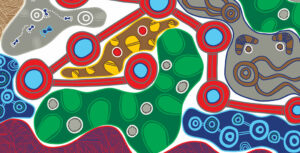First Peoples artwork represents journey to incorporate Indigenous ways of knowing and being into public sector practice
9 February 2021
● News and media
ANZSOG’s upcoming Proud Partnerships in Place: First Peoples public administration virtual conference will feature original Māori and Aboriginal artwork designed to inspire attendees and represent the journey ANZSOG is undertaking to work with First Peoples and incorporate their knowledge and culture into all aspects of our work.
ANZSOG Dean and CEO Ken Smith said that ANZSOG had featured Indigenous artwork in all three of its First Peoples conferences in recognition of the essential nature of story telling, art and creativity to Indigenous cultures.
“Proud Partnerships will be about exploring the many strengths and deep knowledge in Indigenous communities and how governments can build genuine partnerships which harness those strengths to drive change,” he said.
“This beautiful artwork illustrates the journey we are on, and what we are trying to achieve through our First Peoples conferences – events that build connections and provide a vital forum to share the aspirations and successes of First Peoples.”
The commissioned artwork ‘Te Haerenga’ (The Journey) has been produced by Māori artist Aaron McTaggart (Te Arawa – Ngati Whakaue, Ngati Rangi Wewehi) who was born in Rotorua, New Zealand and has been living in Sydney for 17 years with his whanau (family). He has exhibited in many galleries in Australia and was a feature artist in the ‘Pasifika’ Exhibition at the Casula Powerhouse Museum in Sydney in 2014.

Te Haerenga (The Journey) – Aaron McTaggart
His work is a contemporary interpretation of Māori art forms used in Raranga (weaving) including Harakeke (flax), Tukutuku (decorative woven panels used to adorn the walls of a Māori meeting house to record their history) and Ta Moko (tattoos, a visual story which connects the person to their Whakapapa (genealogy) and Māoritanga (culture). Mr McTaggart says he endeavours to put Wairua (spirit) and Aroha (feeling) into every visual interpretation, to bring a fresh perspective to tell the story.
He said that Te Haerenga told a stylised story blending Māori history and ANZSOG’s mission to improve government.
“This stylised story begins in the top left corner when Māori arrived in Aotearoa-New Zealand and Marama (moon) illuminated Te Po (darkness) and past descendants guided our Tupuna (ancestors) to navigate the ocean to discover Aotearoa (land of the long white cloud),” he said.
“Underneath this, the brow of the Waka (canoe) represents Māori embarking on the epic journey to become Tangata Whenua (first people of the land). The green at the bottom left is the fertile land of Aotearoa, representing the balance of nature and knowledge of Māori to provide food and medicine for generations, to sustain their Iwi (tribes), Hapu (sub-tribes) and Whanau (families).
“The two blue sections at the top represent the Wai (water) between Australia and New Zealand, and while it keeps us apart – water is the essence of all life and pays homage to the Mauri (life force) that strongly connects Māori, Aboriginal and Torres Strait Islander People to water.
“At the top, is a brown and red Koru (a symbol of new growth, new beginnings, new relationships) that is surrounded by light blue lines with a red centre. The other black and yellow Koru encompasses Māori Tikanga (customs and protocols) that keep Māori connected to their identity. Inside the Koru, community is the focus – people living and working together to achieve better outcomes for their Tamariki (children) and ultimately our communities.
“The brown ‘fields’ in the bottom right represent the culture, perspectives and values of Aboriginal, Torres Strait Islander People and Māori, that can better inform the work of the public sector, academics and community agencies.
“The green section on the right hand side represents the environment and how essential it is for the wellbeing of all First Peoples cultures. Beneath this, the brown and red earth of Australia depicts the critical importance of caring for Whenua (land/country), to the generations of Indigenous Kaitiaki of the land.”
“In the centre, the small black and red triangles inside the white curved line, symbolise the steps ANZSOG has taken since it began its journey in 2002.
He said the journey and milestones ANZSOG has achieved thus far are illustrated beneath the steps. The grey pathway that moves beyond these milestones signifies the journey ahead and the achievements and stories yet to unfold.
“The cross hatch design in the bottom right depicts the reward that is nurtured and reaped through education. The purpose of ANZSOG is paramount, to continually provide the public sector, academics and community leaders with the knowledge to develop the best public administration tools to achieve the best outcomes for all First Peoples.”
For its 2019 First Peoples conference Reimagining Public Administration, held in Melbourne, ANZSOG commissioned an original artwork – “Journey – where we have been & where we are going” – from local Indigenous painter Emma Bamblett. The artwork will be used again as part of promotions for Proud Partnerships.

Journey – where we have been & where we are going – Emma Bamblett
A proud Wemba Wemba woman, born and raised in Echuca on the Murray River, she has found inspiration and motivation from the arts community in Melbourne as well as working in the Aboriginal child and family welfare sector. “Journey” represents coming together, journey and connection – all themes of the Reimagining Public Administration conference.
Most of Ms Bamblett’s artwork is deeply personal, representing the stories and struggles for vulnerable children, youth and families through whom she meets in her occupation.

Aaron McTaggart and Emma Bamblett
She said that the painting was a ‘representation of where we have been and where we are going’.
“You will see bright colours of red and yellow in the rivers, with continuous lines to represent the rivers which surround the area where the conference was held,”
“The footsteps in the top left corner represent the role of ANZSOG in providing leadership, support and guidance to those working in the public sector.
“The brown areas with the yellow hills represent Aboriginal and Torres Strait Islander people, the dots in the middle of the circles represent their skin colour and the red represents the earth, while the green area with the hills and grey circles represent Māori -the First Peoples of New Zealand.
“The hills signify the importance of land and country and the importance of connection.
“All the elements in this painting represent coming together, journey and connection. I believe these are elements which are representative of ANZSOG’s mission to support and provide leadership to the public sector and provide effective outcomes for our community.”
For more information about the Proud Partnerships conference or to register, visit the conference webpage.
